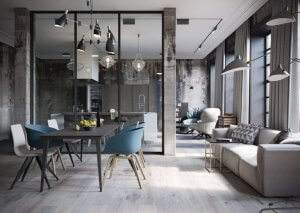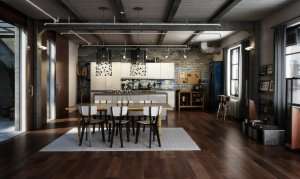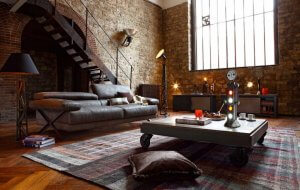High-Tech Style - Designs with an Industrial Edge

High-tech style uses materials and techniques that create stylish and practical spaces with an industrial edge. In architecture, the term “high-tech” refers to the style developed in the 1960s by British architects Norman Foster, Richard Rogers, and Michael Hopkins.
The high-tech trend is known for its passion for advanced technology and for showing off techniques and materials that are frequently used in building construction. Interior designers later began to follow the same artistic trend, continuing the obsession with technology.
The high-tech style technique

High-tech designs often take great pride in their structural components, including their beams, piping, and ducts, which go from being solely functional to being decorative.
This style often evokes the concepts of manufacturing and industrial production, while it avoids anything that might be associated with artisan or unprocessed products.
High-tech spaces often use structures from industrial design, such as stainless steel spiral staircases or construction site scaffolding.
It’s also common in high-tech design to paint piping to make it stand out or to use over-sized piping. Similarly, many designers also use unconventional flooring in high-tech spaces, such as concrete, vinyl tiles, or re-used carpets from commercial properties.
Style versus functionality

High-tech interiors should ideally be open and full of light. This is to avoid them feeling cold, which can happen when trying to create a space with an industrial aesthetic.
To separate rooms, designers try to avoid using conventional walls. Where possible, they instead use glass window panes, metal lattices, or simply curtains to separate spaces.
As the name would suggest, high-tech style goes hand in hand with developments in advanced technology. These designs use the latest domestic appliances, audiovisual devices, and computers. In addition to being practical, these gadgets are great decorative additions to these spaces.
High-tech furniture and materials

While the furniture used in high-tech spaces is functional, it also has the “technological” edge and can sometimes even be quite futuristic. These spaces avoid superfluous decorations or details.
One of the most distinctive features of high-tech design is that it uses objects originally from industrial spaces. These can include, for example, metal shelving from bookcases, PVC piping from towel rails, or crates from storage units.
To create a high-tech space, it’s important to use synthetic and modern materials. The most commonly used materials are metal, steel, glass, and plastic.
In terms of the fabrics and upholstery used in high-tech spaces, it’s best to opt for fabrics such as nylon and canvas. It’s also important to avoid natural materials like leather, wicker, and wood, even if they appear to have the “tech” look.
Simple and functional design in high-tech style

The high-tech doesn’t need a lot of unnecessary decorations. Only a few accessories are needed in a high-tech space and they should be functional.
It’s also a really good idea to hang curtains rather than blinds. If you opt for curtains, they should be very simple in shape and a plain color.
When it comes to decorating your walls, large unframed abstract paintings are the best option. Black and white photographs can also work well, no matter their subject. However, photographs of architecture and art can help you can achieve that perfect high-tech look.
Modern sculptures, preferably those made out of iron or steel, also work well in high-tech spaces.
How to avoid your high-tech style feeling cold

When creating a high-tech space, there is some risk that the space will feel quite cold. One way to avoid this is by being clever with how you use color.
For structural components, it’s best to use neutral colors, such as white, grey, cream, and beige. For upholstery, furniture, and fabrics in your home, solid colors and geometric designs could work well, as they could help to give your space a personal touch.
So, are you ready to try out a high-tech style in your home?
High-tech style uses materials and techniques that create stylish and practical spaces with an industrial edge. In architecture, the term “high-tech” refers to the style developed in the 1960s by British architects Norman Foster, Richard Rogers, and Michael Hopkins.
The high-tech trend is known for its passion for advanced technology and for showing off techniques and materials that are frequently used in building construction. Interior designers later began to follow the same artistic trend, continuing the obsession with technology.
The high-tech style technique

High-tech designs often take great pride in their structural components, including their beams, piping, and ducts, which go from being solely functional to being decorative.
This style often evokes the concepts of manufacturing and industrial production, while it avoids anything that might be associated with artisan or unprocessed products.
High-tech spaces often use structures from industrial design, such as stainless steel spiral staircases or construction site scaffolding.
It’s also common in high-tech design to paint piping to make it stand out or to use over-sized piping. Similarly, many designers also use unconventional flooring in high-tech spaces, such as concrete, vinyl tiles, or re-used carpets from commercial properties.
Style versus functionality

High-tech interiors should ideally be open and full of light. This is to avoid them feeling cold, which can happen when trying to create a space with an industrial aesthetic.
To separate rooms, designers try to avoid using conventional walls. Where possible, they instead use glass window panes, metal lattices, or simply curtains to separate spaces.
As the name would suggest, high-tech style goes hand in hand with developments in advanced technology. These designs use the latest domestic appliances, audiovisual devices, and computers. In addition to being practical, these gadgets are great decorative additions to these spaces.
High-tech furniture and materials

While the furniture used in high-tech spaces is functional, it also has the “technological” edge and can sometimes even be quite futuristic. These spaces avoid superfluous decorations or details.
One of the most distinctive features of high-tech design is that it uses objects originally from industrial spaces. These can include, for example, metal shelving from bookcases, PVC piping from towel rails, or crates from storage units.
To create a high-tech space, it’s important to use synthetic and modern materials. The most commonly used materials are metal, steel, glass, and plastic.
In terms of the fabrics and upholstery used in high-tech spaces, it’s best to opt for fabrics such as nylon and canvas. It’s also important to avoid natural materials like leather, wicker, and wood, even if they appear to have the “tech” look.
Simple and functional design in high-tech style

The high-tech doesn’t need a lot of unnecessary decorations. Only a few accessories are needed in a high-tech space and they should be functional.
It’s also a really good idea to hang curtains rather than blinds. If you opt for curtains, they should be very simple in shape and a plain color.
When it comes to decorating your walls, large unframed abstract paintings are the best option. Black and white photographs can also work well, no matter their subject. However, photographs of architecture and art can help you can achieve that perfect high-tech look.
Modern sculptures, preferably those made out of iron or steel, also work well in high-tech spaces.
How to avoid your high-tech style feeling cold

When creating a high-tech space, there is some risk that the space will feel quite cold. One way to avoid this is by being clever with how you use color.
For structural components, it’s best to use neutral colors, such as white, grey, cream, and beige. For upholstery, furniture, and fabrics in your home, solid colors and geometric designs could work well, as they could help to give your space a personal touch.
So, are you ready to try out a high-tech style in your home?







